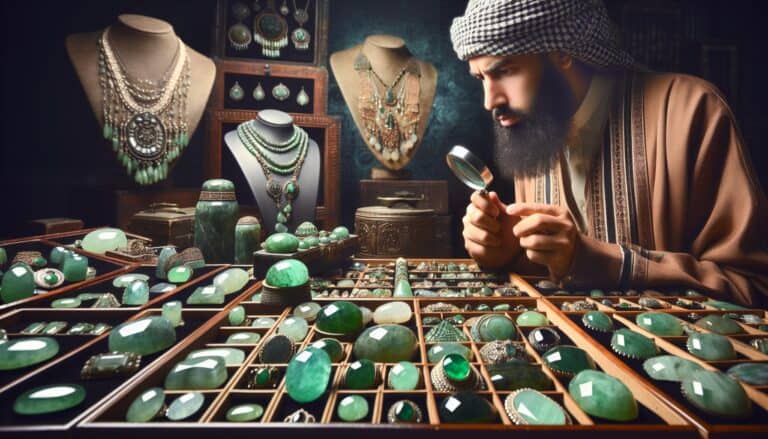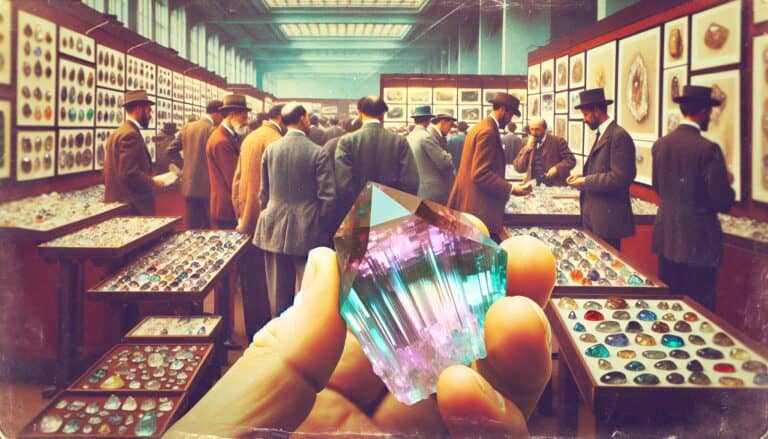Ever wondered what that shiny piece of calcite on your shelf is worth?
You’re not alone. Calcite, a versatile mineral found in everything from construction materials to jewelry, can vary widely in value. Its worth hinges on several factors, from purity to color, and understanding these can help you determine its real value.
Whether you’re a collector, investor, or just curious, getting to grips with calcite’s value is crucial. You’ll find that it’s not just the size that matters, but also the quality and rarity.
Let’s dive into what makes calcite a gem—or just another stone—in the market.
Calcite’s value depends on factors like color, clarity, and rarity. Vivid colors and high clarity increase worth, while market demand influences pricing. Collectible calcite, like optical grade or unique colors, can fetch higher prices. When buying, seek quality specimens from reputable sources and consider professional appraisals for authenticity.
What Is Calcite?
Calcite is a carbonate mineral and the most stable polymorph of calcium carbonate (CaCO3). It’s not just any rock—it’s a part of many of the natural wonders you admire and an integral component of the products you use daily.
You’ll find calcite everywhere. It lurks in the sturdy walls of your house as part of the cement and plaster, adds the gloss to your glossy paper, and even purifies your drinking water. It’s a chameleon in the mineral world, often present yet frequently overlooked.
One of calcite’s most noted physical properties is its rhombohedral cleavage. This means that if you were to strike a piece of calcite, it would split into a shiny, geometric marvel—a quality highly sought after by mineral collectors. It also comes in the form of masses and nodules in sedimentary rocks such as limestone and marble, which are extensively quarried for architectural use.
- Water Treatment: Calcite’s ability to neutralize acids makes it vital in maintaining the pH balance of water supplies.
- Agricultural Aid: Farmers use calcite to enrich their soils, thanks to its elemental calcium—a nutrient crucial for plant growth.
- Industrial Uses: From the rubber in your tires to the plastics in your gadgets, calcite serves as a filler material due to its abundance and low cost.
Furthermore, its versatility extends into the realm of personal care products, acting as a gentle abrasive in toothpaste and a buffering agent in antacids. Its optical properties are harnessed in creating polarizing microscopes, which scientists use to study the hidden details of materials.
When you’re looking at sheer economic value, the purity and form of calcite can ramp up its worth considerably. Manufacturers prize high-grade calcite for its absence of impurities, ensuring a higher quality product. In contrast, items like collectible crystals are valued more for their aesthetic attributes than their practical applications.
Understanding the multifaceted role of calcite in both industry and art helps you better grasp the underlying factors that contribute to its value. Far from being a mundane rock, calcite’s myriad uses make it a cornerstone of human civilization.
Calcite Prices: Factors That Affect Value

When you’re looking into calcite, you’ll find that its price can vary widely depending on several key factors. Each of these influences the final value of calcite, making some forms more expensive than others. Let’s delve into what makes one piece of calcite more valuable than another.
Color, Clarity, and Cut Quality
Color is a significant determinant of calcite’s value. The more vivid and pure the color, the higher the price it commands. Colors like clear, smoky colors, or those that display phenomena such as iridescence can elevate a piece’s value.
The clarity of calcite also plays a role. Stones with fewer inclusions – those tiny internal fractures or minerals – tend to be more prized. High clarity calcite not only looks better but also reflects light more brilliantly, making it sought after for decorative uses.
Lastly, the cut quality can either highlight the stone’s attributes or detract from its natural beauty. Precision-cut calcite is more valuable as it demonstrates skill and can bring out the best in the mineral’s optical properties.
Market Demand and Availability
Calcite’s value is also greatly influenced by market demand and its availability. If there’s a trend for calcite decor or jewelry, you can expect prices to be higher due to increased demand. Certain colors may also be in trend, boosting their prices temporarily.
Availability, on the other hand, dictates the rarity. Calcite deposits are widespread; however, some unique forms or colors of calcite are less abundant. For instance, blue calcite is rarer than other types and can fetch a higher market price due to its scarcity.
Keep in mind that the location of the calcite deposits affects both availability and total cost. Deposits that are difficult to access or are in regions with higher mining costs can lead to a higher price for the raw material. When you’re looking to buy calcite, these are crucial aspects to consider to understand the expense behind each piece.
Understanding Calcite: A Rare Gem

The Rarity of Calcite
When exploring the vast world of minerals, you’ll find that calcite stands out due to its unique occurrence in nature. It’s not as abundant as more common minerals like quartz, which makes it a sought-after specimen for collectors and enthusiasts. The rarity of calcite is directly tied to its formation process and specific environmental conditions that are not always easy to come by.
Geological rarity plays a significant role in the value of calcite. As a rule of thumb, the harder it is to find, the more it’s generally worth. Some unique forms of calcite—such as optical calcite, also known as Icelandic Spar—are prized for their clarity and ability to diffract light. It’s these rarities that catch the eye of gem lovers and increase the value of calcite in the marketplace.
Keep in mind that not all calcite specimens are considered rare. For example, the common white or transparent variants are quite plentiful and typically fetch a lower price. However, vividly colored and transparent crystals, which are much less common, tend to be on the higher end of the price spectrum.
Origins and Characteristics
Calcite originates from both igneous and sedimentary processes, but it’s most commonly formed through sedimentation. The process involves the precipitation of calcium carbonate from lake or ocean water. Over time, this results in large deposits of calcite that can be mined. These deposits are found all over the world, granting calcite a global significance.
The characteristics of calcite also contribute to its fascination and worth. With a chemical formula of CaCO3, calcite boasts a wide array of forms and colors due to various impurities. It’s not unusual to find calcite in colors ranging from white to black, with shades of red, yellow, and blue in between.
Moreover, calcite has a unique property known as double refraction. When you place a clear piece of calcite over text, you’ll see the letters doubled, a feature that’s not only captivating but also of interest to researchers and technology developers.
Additionally, calcite exhibits fluorescence under UV light and, in some cases, phosphorescence. These additional properties can greatly enhance the visual appeal and, in turn, the potential value of specific calcite samples.
When assessing the origins and characteristics of calcite, remember that each piece tells a story of millions of years, from its formation to your collection. Whether you’re a seasoned collector or new to the gem world, recognizing the interplay of rarity, origin, and distinctive qualities can give you deeper insight into the worth of calcite.
Calcite Grading and Valuation
The Grading System for Calcite
The grading of calcite plays a crucial role in determining its market value. Unlike diamonds, which follow a universal grading system (the Four Cs), calcite doesn’t have a widely standardized scale. However, experts assess calcite based on similar criteria:
- Purity: The absence of impurities that may detract from calcite’s clarity is a significant indicator of grade.
- Color: Pure calcite is naturally transparent or white, but can appear in other colors due to impurities. Some hues are more sought after than others.
- Size and weight: Larger, high-quality calcite specimens are typically more valuable.
- Clarity: Clear, transparent calcite stones, especially in optical grades, fetch higher prices.
- Shape: Naturally well-defined crystals command more attention and can enhance the value.
Understanding these grading criteria helps you better estimate the worth of a calcite piece. Be mindful that the perceived value can also vary based on current market demand and geological rarity.
Certification and Appraisal
Having your calcite certified by a respected institution can significantly impact its valuation. Certification lends credibility, confirming the authenticity and quality of the mineral. During the appraisal process, a certified gemologist or mineral expert will typically:
- Conduct a thorough examination of the calcite specimen.
- Document the grade based on the aforementioned criteria.
- Provide an official certificate that can be critical for buyers and sellers alike.
The appraisal process can also uncover unique features of your calcite, such as its history of formation, geographic origin, and any historical significance, all of which can contribute to its market value. Remember, whether you’re collecting calcite as a hobby or investment, ensure that your pieces are appraised by qualified professionals. This not only increases the likelihood of a good return on your investment but also protects you against the pitfalls of an unpredictable market.
Current Market Trends in Calcite Pricing
Calcite’s value in the market can fluctuate based on a variety of factors that impact supply and demand. One prevalent trend is the growing demand in construction and renovation markets, especially in emerging economies. As urbanization spreads, the need for building materials that contain calcite, such as cement and plaster, continues to surge.
Technological advancements are also shaping calcite pricing. Innovations in processing and refinement have led to more efficient use of calcite, potentially lowering costs. However, the introduction of high-quality synthetic substitutes for certain applications could pose a threat to natural calcite’s market share and affect its price.
In the agriculture sector, the use of calcite as a soil amendment is on the rise. The emphasis on sustainable farming practices and organic farming has boosted demand for calcite due to its effectiveness in adjusting soil pH levels. This, in turn, has a positive impact on its value.
The personal care industry contributes to the market dynamics as well. With an increasing consumer focus on natural and sustainable products, calcite is often preferred as a mild abrasive in toothpaste and as a talc substitute in cosmetics. This steady demand from the personal care sector helps maintain calcite’s worth.
In the realm of high-grade, collectible minerals, rarity and aesthetic appeal play significant roles in pricing. Specimens with exceptional clarity and unique formations often fetch higher prices, reflecting their desirability to collectors and enthusiasts.
It’s essential for buyers and sellers alike to stay informed about current market trends. Understanding these trends helps in making knowledgeable decisions when buying or selling calcite. Staying updated on industry news and global economic factors will give you an edge in evaluating the true worth of calcite. Keep an eye on trade journals, market reports, and commodity indexes for the latest information regarding calcite pricing.
The Most Expensive Calcite
When exploring the upper echelons of calcite specimens, you’ll find that the rarity, size, and aesthetic appeal significantly spike their values. Collector-grade calcite, often showcasing exceptional crystal clarity and vibrant colors, can fetch premium prices on the market. The value is also heightened when the specimens are associated with historic locations or have unique features like fluorescence under UV light.
The record-breaking calcite pieces come from renowned mines that have a storied past in producing museum-quality minerals. Mines in locations like Elmwood in Tennessee, or the Sweetwater mine in Missouri, have yielded large and lustrous calcite crystals that are sought after by high-end collectors and institutions. The prices of such exceptional pieces can climb well into the thousands, depending on their desirability and condition.
For instance, a large, well-formed Amber-colored calcite crystal from China or Mexico, surpassing ten inches in size and displaying a perfect rhombohedral shape, can be valued at several thousand dollars. In contrast, a smaller yet flawless crystal cluster from a coveted locale might command a similar price due to its provenance.
In recent years, the interest in metaphysical properties has additionally influenced calcite’s value. Crystals that are believed to possess certain energy attributes can be especially expensive. This trend intertwines with the aesthetics of a piece to create a niche market where calcite isn’t just a mineralogical specimen but also an object of spiritual significance.
| Feature | Impact on Calcite Value |
|---|---|
| Rarity | Greatly increases price |
| Size | Larger pieces are more valuable |
| Color and Clarity | Desired traits boost value |
| Provenance | Historic origins can add worth |
| Metaphysical Claim | May enhance value in niche markets |
As you delve into the market for high-grade calcite, it’s important to be aware of these factors and to consider the reputation of the dealers. Verified sources and authenticity certificates often accompany the most expensive calcite to ensure buyers that they’re getting a genuine piece worth their investment.
Buying Calcite: Tips and Recommendations
When you’re in the market for calcite, finding high-quality specimens is paramount. Quality directly influences value, and knowing where to shop is half the battle. Whether you’re a collector or a professional seeking calcite for industrial use, you’ll want to make informed decisions to secure the best deals. Here’s how to go about it.
Where to Purchase High-Quality Calcite
There are several avenues you can explore when looking to purchase high-grade calcite:
- Specialty Gem and Mineral Shows: These events often host a plethora of vendors specializing in quality minerals. You’ll find a diverse range of calcite, from affordable pieces to collector’s gems.
- Reputable Online Retailers: Many trusted sellers operate online, providing detailed descriptions and images of their wares. Ensure the site has positive reviews and robust return policies.
- Local Mineral Shops: Visiting local shops allows you to physically inspect calcite samples. It also gives you the chance to engage with knowledgeable staff who can provide valuable insights.
- Auctions: Both physical and online auctions can be goldmines for finding exceptional calcite specimens. However, be aware that bidding wars can inflate prices.
Remember to check for any upcoming shows or auctions in your area and to research online marketplaces that specifically cater to minerals. Prioritize sellers with transparency in pricing and who provide ample detail about each piece.
Ensuring Authenticity and Value
When buying calcite, securing authentic and valuable specimens is crucial:
- Request Documentation: For high-end calcite, ask for any certificates of authenticity or provenance. Documentation should include information on the origin, quality, and any unique characteristics of the specimen.
- Understand Pricing Factors: Familiarize yourself with aspects that influence calcite’s price, such as color, clarity, size, and rarity. This knowledge helps you discern if a piece is fairly priced.
- Professional Appraisal: For substantial investments, consider getting a professional appraisal. This step is particularly important for collector-grade items or if you plan to resell the mineral.
- Visual Inspection: Examine the calcite closely. Look for natural patterns, consistent coloring, and signs that match the seller’s description. A loupe or magnifier can be handy for this purpose.
Staying vigilant about authenticity not only safeguards your investment but also ensures you’re building a collection of genuine worth. Trust your instincts and don’t hesitate to ask for more information or verification when needed. By shopping smartly and keeping an eye out for quality and authenticity, you’ll be well-equipped to make excellent calcite purchases that stand the test of time.
Remember, whether for personal enjoyment or professional use, the value of your calcite is in its authenticity and quality. Keep your standards high, and don’t settle for less than you deserve.
Conclusion: Buying & Selling Calcite
Understanding the true worth of calcite means recognizing its role in various industries and its value as a mineral.
Remember, the quality of calcite you seek should align with your intended use, whether for manufacturing, collection, or personal projects. Don’t hesitate to seek out the best sources, insist on documentation, and do your homework to ensure you’re getting the most for your money. With the right approach, you’ll find that investing in high-grade calcite is not just about the price—it’s about the lasting value and utility it brings to the table.
Shop smartly, and your calcite purchases will be as rewarding as they are valuable.


![Oregon Rockhounding Sites in [year]: Gems & Gold Spots](https://observationhobbies.com/wp-content/uploads/2024/01/zvbNyGO3hFnie_QEOh9l0-768x439.jpg)

![Ohio Rockhounding Sites in [year]: Spots & Treasures](https://observationhobbies.com/wp-content/uploads/2024/01/vqJV6LfGkDrfpCSMU6rRr-768x439.jpg)

![PA Rockhounding Sites in [year]: Spots & Treasures](https://observationhobbies.com/wp-content/uploads/2024/01/Tga-ze11rwaKDz9VFfT9I-768x439.jpg)
